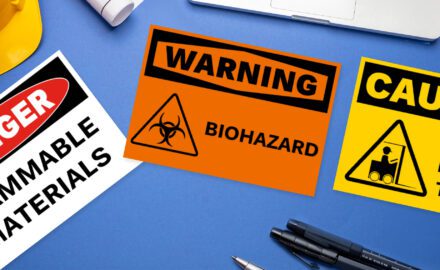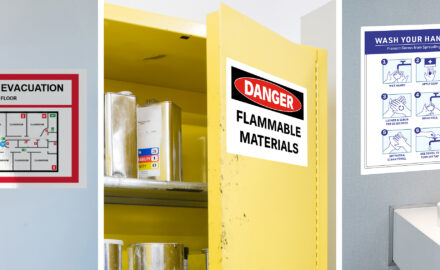The importance of GHS label compliance
With the deadlines for Globally Harmonized System (GHS) label compliance now past for chemical manufacturers, distributors, and end users, OSHA has some stiff fines planned for those not yet with the program.

Who can benefit from upgrading their GHS labeling process
Choosing the right GHS labeling options can cut the complexity as well as make production safer. This is critical for end users, who may not yet be fully GHS label compliant after the most recent June 1, 2016 deadline.
On the other hand, manufacturers, distributors and end users that are already compliant may want to streamline the process. In these cases, choosing the right GHS labeling products and software can greatly increase efficiency.
Types of chemicals that require GHS labels
For end users, GHS label compliance is required for chemical formulations purchased in bulk containers for cost savings. For example, barrels of industrial cleaner that are transferred to smaller “down-packed” (secondary) containers, such as spray bottles for portable use.
Containers requiring compliant GHS labels can vary in size from 55-gallon drums down to tiny test vials. In an industrial setting, chemical formulations that could require GHS labels cover a wide range, including:
- Industrial primers, coatings and sealants
- Lubricants such as greases and cutting oils
- Rust removers
- Acid, alkaline, and solvent-based cleaners
- Degreasers and surfactants
- Disinfectants, and sanitizers
Learn more about chemicals that require labels in our free white paper covering GHS labeling requirements or a quick read with tips for acing secondary container compliance.
A metal manufacturer requiring compliant GHS labels
We talked to David Herberling, a Quality Metallurgist and Safety Manager at a large metal supply service center in Ohio, about proactively seeking GHS label solutions for “down-packed” secondary container labeling.
According to Herberling, down-packing was necessary from 55-gallon drums to smaller containers with spray nozzles. The applications involve spraying oils, solvents, and lubricants onto product surfaces and into production line equipment that produces flat-rolled steel, in coils and cut lengths.
Finding the right durable GHS labels for compliance
“Label durability is important to us, so we turned to Avery’s UltraDuty GHS Chemical Labels,” says Heberling.
Avery GHS labels are industrial-grade labels designed to be chemical resistant, tear resistant, abrasion resistant, and constructed with a marine-grade adhesive that is waterproof and passes BS5609 durability tests for marine and extreme environments.
Designing compliant GHS labels using Avery label software
Just as important to Heberling, if not more so, was the ease of use of the online label design software, available from the company’s website at no cost. Avery Design and Print Online allows users to create and print their own GHS and HMIS labels from predesigned templates.
Herberling liked that his team could create on demand labels step-by-step at their desk, as well as create GHS labels and HMIS hybrid labels capable of satisfying both systems. Most of the team found the process intuitive, resembling creating an office document from predesigned templates.
With the Avery GHS Wizard® subscription service, users can access advanced GHS tools in addition to the standard label design tools available in Avery Design and Print Online.
“What I really needed was the chemical name, hazards, pictograms, and precautions for internal company use,” says Heberling. “I like that when I entered the CAS number for the main chemical ingredient from the safety data sheet, the GHS Wizard filled these in and allowed me to modify them to suit our situation as appropriate. Most of the work was done for me.”
Combining information for GHS labels
Avery Design and Print Online allows customizable text; insertion of company logo or other images; generation of 18 types of barcodes; and a sequential numbering feature to add lot numbers or other variable data.
The GHS Wizard autofills the product identifier, signal word, hazard statements precautionary statements and pictograms needed for GHS labeling. All information can be reviewed and edited. Additionally, English and Spanish statements can be added to create a bilingual GHS label.
No download is required since the software operates from the Avery website. HMIS, NFPA and GHS labels can be securely saved online or to a computer. The software is also capable of creating other safety labels such as OSHA, ANSI, and DOT labels using standard features.
“The ability to convey needed GHS label info clearly, as well as combine it with other systems like HMIS and NFPA can be helpful when hybrid systems are required,” says Howell. “Software with modifiable templates like Avery’s allows you to quickly create GHS labels for your specific product, in the quantities you need, at the time you need them.”
Facility-wide GHS label compliance in a couple hours
According to Heberling, relying on Avery software with GHS tools along with the appropriate GHS labels enabled his metal supply service center to become GHS compliant rapidly.
“Once we had the labels, we complied with GHS requirements within a couple of hours,” says Heberling. “I printed what we needed on a desktop printer, and we affixed the labels to painted secondary containers with spray nozzles at the production lines. What initially looked like a big project actually turned out to be quite simple.”
Compliant while improving safety on the production line
Since then, the compliant GHS labels in Herberling’s facility have not only passed a corporate audit, but also improved the safety of the production lines and employees.
GHS label compliance helps improve safety by minimizing the risk of chemical misidentification and mishandling along the entire supply chain. From manufacturer to end user, both domestically and internationally.
“While GHS label compliance was mandatory, so was passing all safety audits,” says Heberling. “The real bottom line, however, is that becoming GHS label compliant has improved our safety at the production lines. Now we are clearly displaying chemical data to prevent mistakes of misidentification, along with other necessary information.”
More resources for GHS label compliance
- Get started fast with a quick and dirty guide to GHS label compliance and tips for creating your own GHS labels onsite
- Watch a video to explore the features of our GHS Wizard software that auto-fills predesigned GHS label templates in under five minutes
- Shop award-winning UltraDuty® GHS labels you can print onsite using standard printers
Please note, the contents of this article and related articles on avery.com/industrial are for informational purposes only, are general in nature, and are not intended to and should not be relied upon or construed as a legal opinion or legal advice regarding any specific issue or factual circumstance.



